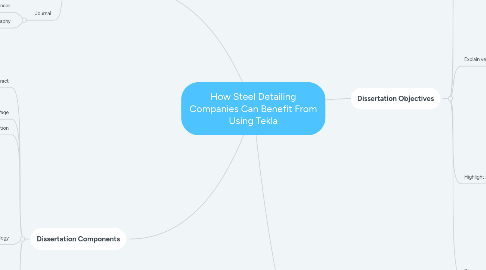
1. Dissertation Components
1.1. Abstract
1.1.1. What the project will consider
1.1.2. Expected outcomes
1.1.3. Project Aims
1.2. Contents Page
1.3. Introduction
1.3.1. Hypothesis
1.4. Methodology
1.4.1. Research
1.4.1.1. Main advantages of Tekla
1.4.1.2. Onsite BIM uses
1.4.1.2.1. Totalstations
1.4.1.2.2. Use of tablets to view CAD models
1.4.1.2.3. 3D Scanning
1.4.1.3. Tekla Disadvantages
1.4.1.3.1. Cost
1.4.1.3.2. Complexity
1.4.1.3.3. Length of time needed to train
1.4.1.3.4. Constant support - updates needed
1.4.1.4. Main types of BIM
1.4.1.4.1. 2D Drawing packages
1.4.1.4.2. 3D Drawing packages
1.4.1.4.3. Parametric CAD
1.4.1.4.4. Point cloud models
1.4.1.4.5. VR CAD
1.5. Literature Review
1.6. Conclusion
1.6.1. Evaluate and conclude findings from research
1.6.2. Discuss if the industry standard is affected by the use of Tekla and how it can change the way people work.
1.6.3. Conclude any limitations and offer solution
2. Appendices
2.1. Proposal
2.1.1. Types of resources used
2.1.1.1. Plan for how to collect research
2.1.1.2. Programme of works, specific plan with deadlines
2.2. Analysis/Development plan
2.3. Journal
2.3.1. References
2.3.2. Bibliography
3. Dissertation Objectives
3.1. Define complexity of construction
3.2. Define what Tekla is
3.2.1. History of Tekla
3.2.2. Discuss uses
3.2.3. Different types of BIM (Structural)
3.2.3.1. 2D
3.2.3.2. 3D
3.2.3.3. Point Cloud
3.2.3.4. VR
3.3. Explain versatility of BIM
3.3.1. Sustainability
3.3.1.1. Less waste
3.3.1.2. Econimical value
3.3.1.3. Social value
3.3.2. Highlight how different companies can benefit from using certain BIM packages
3.3.2.1. Civil design
3.3.2.2. Structural design
3.3.2.3. Structural detailing
3.3.2.4. Mechanical design
3.3.2.5. Electrical design
3.3.2.6. Heating Design
3.4. Highlight advantages
3.4.1. Productivity
3.4.2. Long term savings
3.4.3. Accuracy improvements
3.4.4. Standardisation
3.4.5. Customisable
3.4.6. Parametric modelling
3.5. Discuss main issues
3.5.1. Cost
3.5.1.1. initial investment
3.5.1.2. yearly upkeep
3.5.2. Time needed to train
3.5.3. Support needed
3.5.4. Lack of experience
3.5.5. Complexity
4. Case Study Research
4.1. CAD vs Tekla
4.1.1. Fisht Stadium, Sochi
4.1.1.1. Industry Case Studies
4.1.2. Castle House Tower, London
4.1.3. ArtScience Museum, Singapore
4.1.4. National Museum of Qatar, Doha
4.1.5. New Mont Blanc Ropeways
4.1.6. Gardens At Bay
